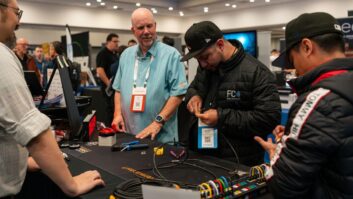The last thing this industry needs is a “price war” right about now. But that’s what may be happening if you believe all the industry chatter in recent weeks.Accusations from both suppliers and retailers that predatory pricing may be the rule in flat-panel TVs and other key categories this holiday season are the talk of the industry.
The culprits in this battle are, allegedly, the industry’s two top retailers, Best Buy and Wal-Mart.
They are supposedly pressing their suppliers to the limit to gain a competitive advantage this holiday season. Retailers and suppliers – whether they participate or not in this race to the bottom – will be hurt. None of that is new.
What is new is that since the economy is reeling from the ill effects of the worst recession since World War II, a price war would seriously impact the entire industry’s profitability, a fragile creature in the best of times.
When contacted by TWICE this week, neither Best Buy nor Wal-Mart had much to say about this, citing their policies and competitive reasons. Names of suppliers that have dropped prices on specific model numbers to major retailers are either non-existent or not verifiable.
Maybe these are just rumors stoked by the weariness of living through this recession? Maybe suppliers and competing retailers are just pointing fingers away from themselves to avoid blame?
When it comes to price cutting in the CE business, facts are always hard to come by, which is why this is written as an opinion piece, rather than a news story. But based on my experience, some of the allegations being made are probably true.
Wal-Mart did reiterate its philosophy in its response to TWICE’s request for information on these rumors: “Providing customers the best value on their purchases at Walmart is not anything new to our business, our reputation or our focus … [and] we have continued to grow our offerings of great CE brands and assortment.”
For Best Buy’s competitive thinking at the moment, check the comments by CEO Brian Dunn earlier this week. He highlighted the chain’s market share gains in its fiscal second quarter. Circuit City’s closing “created an opportunity for customer acquisition.” And Dunn added that Best Buy “will always be there on price,” but that this situation enables it “to connect price to service. Over time we will take share and build loyalty.”
Circuit City’s end may have ushered in the beginning of a new era where CE will be controlled by its two biggest retailers. Maybe, but I’ve heard about a few “eras” in CE retailing from years ago and lived though a couple more, and I’d venture to say that many of today’s best retailers, both large and small, will survive and thrive.
For instance, Jim Ristow, general manager of HES, said at CEDIA that his members are entrepreneurs, adapting and changing their business models. They have been looking at CE categories other than audio/video, and outside of the CE industry altogether for increased profits. They have now intensified those efforts.
HTSA, PRO, Nationwide and NATM are saying the same thing. Even Office Depot has decided to cut back on relying on CE products to increase its profits. That’s not good news for the industry.
Low prices and profit margins is this industry’s longest and oldest storyline. There is plenty of blame – or credit if you are a consumer – to go around among current and departed manufacturers and retailers for this industry legacy.
This year many top manufacturers are either just scraping by or posting losses, and it isn’t all due to the recession. Years of shaving profit margins to chase market share have hit home.
If this trend continues, long-term R&D will have to be cut and innovation will lag. Some manufacturers, as we have already seen, may drop key categories or exit CE altogether.
If you are in the industry for the long haul, the era of relying on strategies like taking market share by cutting profits should be reconsidered, at least for the time being. New long-term business strategies that generate profitability and innovation are vital.
Technically we are supposed to be coming out of the recession now. But it will take a couple of years for the U.S. economy to regain the jobs it lost in the past year. It may take even longer for the industry to enjoy the record annual growth rates of this decade.
Let’s not cry for manufacturers, but little or no profitability for them means less innovation for the CE industry, which will result in fewer exciting and useful products for retailers to sell, and sell profitably.
That’s bad news for everyone – manufacturers, retailers and, ultimately, consumers.








